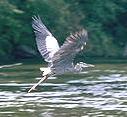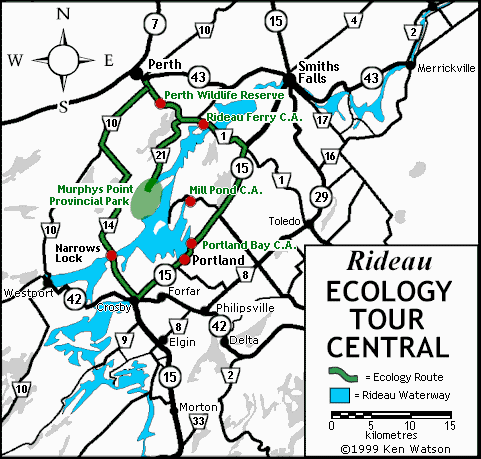
ECOLOGY TOUR - Central Rideau
The Rideau is a host to several different ecosystems. The central portion of the Rideau is underlain by rocks of the Canadian Shield, known as the Frontenac Axis. This shield terrain is characterised by rocky ridges and a series of lakes (the Rideau Lakes). To the south and north of the Frontenac Axis are flat lying sedimentary rocks (limestone, dolomite, sandstone, and shale). This gentle terrain makes for ideal farming country, and the Rideau Waterway in this area is made up of rivers; the Rideau River in the north and the Cataraqui River in the south. Newboro represents the top of the watershed, with water to the south of Newboro, being part of the Cataraqui Watershed, flowing into Lake Ontario and the water to the north of Newboro being part of the Rideau Watershed, flowing into the Ottawa River.
 A new ecosystem was formed with the building of the Rideau Canal in 1826-1832. Some sections of the Cataraqui River were turned into lakes, old marshes were drowned, new marshes were created, and several low lying forested areas were flooded. In the central lakes area, the flooding of forested land created a haven for Largemouth Bass, leading to one of the most spectacular bass fisheries in North America by the late 1800s. On the Rideau today, you can spot many species of birds, including Ospreys and Blue Herons, several species of frogs and turtles (always a favourite with the kids), darting dragonflies, muskrats and beavers, and even the occasional otter. The central lakes host healthy populations of Loons and dozens of species of fish abound in both the lakes and rivers. A new ecosystem was formed with the building of the Rideau Canal in 1826-1832. Some sections of the Cataraqui River were turned into lakes, old marshes were drowned, new marshes were created, and several low lying forested areas were flooded. In the central lakes area, the flooding of forested land created a haven for Largemouth Bass, leading to one of the most spectacular bass fisheries in North America by the late 1800s. On the Rideau today, you can spot many species of birds, including Ospreys and Blue Herons, several species of frogs and turtles (always a favourite with the kids), darting dragonflies, muskrats and beavers, and even the occasional otter. The central lakes host healthy populations of Loons and dozens of species of fish abound in both the lakes and rivers.
In the central Rideau, you will find a blend of hardwood forests, featuring oak, beech, birch, elm, ash and maple trees and coniferous forests, with white pine and spruce. In many areas the white pine tower above the rest of the trees, their wind swept branches a symbol of Canada's natural landscape.
There are many ways to enjoy the ecological diversity of the Rideau. In addition to driving trips, take the opportunity to bring along your boat, or rent one at places like Chaffey's Lock or Portland, and spend a day or two on the water, puttering through the back bays, enjoying the diversities of the natural Rideau habitats.
Those contemplating several visits to the various conservation areas will be interested in obtaining an annual pass, which will allow you unlimited visits during the season to the conservation areas within a single district (Rideau or Cataraqui).
ECOLOGY TOUR CENTRAL
This tour features two options - a tour of the local conservation areas or a visit to Murphys Point Provincial Park. Several of the conservation areas feature boat launches, as does Murphys Point Provincial Park, so bring along the canoe. The conservation areas are maintained by the Rideau Valley Conservation Authority
OPTION 1
Perth via Cty. Rd. 1 to the Perth Wildlife Reserve - The Perth Wildlife Reserve is located a few km east of Perth on Cty. Rd. 1. It features a self guiding nature trail and an observation tower looking over the Tay Marsh, a great place to enjoy the view and see local wildlife.
Perth Wildlife Reserve to the Rideau Ferry Yacht Club Conservation Area - Continue west along Cty. Rd. 1 to Rideau Ferry. Look for the signs for the Rideau Ferry Yacht Club Conservation Area. Featured at this conservation area is a swimming beach, picnic tables, a boat launch and toilet facilities. This is a nice spot for a family picnic.
Rideau Ferry Yacht Club Conservation Area to the Mill Pond Conservation Area - Continue west along Cty. Rd. 1 to Hwy. 15. Take Hwy. 15 south and look for the conservation area signs. Take the Briton-Houghton Bay road, west off Hwy. 15 to the conservation area. The Mill Pond Conservation Area features 15 kilometres of wilderness trails, picnic tables and washrooms. A small boat launch provides access to the water for car top boats.
Mill Pond Conservation area to Portland - There are several opportunities for nature viewing in Portland. At the north end of town is a public boat launch. It is a great place to gain access to Big Rideau Lake and explore some of the local marshes and bays. There is a boardwalk from the boat launch area which provides several wildlife viewing opportunities. Just a few hundred metres south, near the main part of town, is the Portland Bay Conservation Area, a small area with picnic tables and a visitors centre.
Portland to Perth - continue south along Hwy. 15 to Crosby. Turn west onto Cty. Rd. 42 and look for Cty. Rd. 14, heading north, just after the junction with Hwy. 15 and Cty. Rd. 42. Take Cty. Rd. 14 north to Cty. Rd. 10 and back to Perth. On your way you will cross the channel between Big Rideau Lake and Upper Rideau Lake at the Narrows Lockstation. Cty. Rd. 14 winds through interesting countryside, take your time and enjoy the views.
OPTION 2
Murphys Point Provincial Park - located off Cty. Rd. 21, 19 km south of Perth at the top of Big Rideau Lake, this park offers lots of chances for nature viewing. There are opportunities for swimming, birding, picnicking, hiking, fishing and boating. Take a hike along the easy McPharlan House Trail (2.5 km) or the more challenging Rideau Trail (6.5 km) which passes through rugged terrain and wetland within the park. Learn some of the local geology by visiting the former Silver Queen Mine which mined mica and apatite at the turn of the century. Bring your tent or camper and spend a few days. The park features 167 regular campsites (including 30 with electricity) and 16 remote campsites. The park is open from early May to mid-October and from mid-December to early March.


|